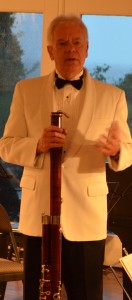Well, the ice is finally gone from the bay and the leaves are trying their best to come fully out into the sunlight. It seems hard to believe that our summer concerts start in just a little over a week.
That reality is even a bit more difficult for Jean and me because we recently returned from a trip to Europe to celebrate our 40th wedding anniversary. It was a river cruise that started in Amsterdam and ended in Budapest. It took us along the Rhine, the Main River, the Main-Danube Canal, and the Danube and through five countries. Several folks have asked us if we heard many concerts while we were there. The truth is, we didn’t hear any real concerts, as such, but we had some interesting musical experiences that were quite touching.
The first was in the famous Keukenhof Gardens near Amsterdam. We had heard so much about this park and its spectacular tulip display, we had to go. However, shortly after entering the garden a pathway through tulips, azaleas, and rhododendron brought us directly in front of an enormous festive looking steam calliope atop a wagon. Its polkas, waltzes, and marches were so mesmerizing in this park-like setting; we stopped dead in our tracks. The grin on Jean’s face was ear-to-ear. “I have to have one of those CDs,” she said pointing to a display rack. On the way out of the park, we bought one after talking with the operator and examining this marvelous instrument, front and back, trying to figure out how it got so many sounds complete with bass drum and cymbals. The effect was similar to what you might experience on a real old-fashioned merry-go-round.
In Cologne, we were dazzled by a marimba player who was blazing through one Rossini overture after another in the plaza next to Germany’s largest Cathedral. Later on, we passed through the same square, and a little boy was equally proficient on the penny whistle. Each brought smiles to our faces and lifted our spirits.
In Nuremberg, I happened upon a group of five male singers in a large square with an enormous open market. They were singing in some Eastern European language as best I can guess. A couple of the singers had really deep voices, which added to the melancholy nature of much of what they sang. But they seemed to really be enjoying themselves, so even their laments were somehow uplifting. In Budapest, there were street musicians everywhere. The most remarkable, perhaps, was the fellow playing a glass harmonica of sorts – numerous glasses partially filed with water to give the exact pitch he wished. He struck these gently with some special mallets. With the help of a little amplification, the tones rang out across the busy plaza as he expertly whizzed through some familiar work by Mozart that I couldn’t quite identify.
The most memorable experiences, however, came in Budapest restaurants where we dined on two different evenings. Both served delicious Hungarian fare with live music as a plus. In one, a gypsy style trio consisted of a violinist, a bass player, and a player on the hammer dulcimer, or cimbalom, as they call it. This is an ethnic instrument that resembles a square piano with no lid where the seated performer leans over it with felt mallets and strikes the exposed strings. After we had a brief conversation with them when they were on break, their performance took on even more personality. They now knew we were musicians and that we were enjoying their fine playing. They played with even more vigor, and we seemed to be getting some extra special attention.
However, this kind of rapport was even more obvious the next evening. A single pianist sat in a quite café playing some very tasteful jazz. As we studied the menu, it was apparent this guy was special. Familiar tunes were decorated with very interesting harmonies, and his body language said he was really enjoying the creative improvisation that was flowing from his hands. He soon noticed that we were picking up on this. The creativity flowed even more freely. Eventually, Jean went up and put a few Euros in the jar on his piano. They spoke briefly. Now he knew why we were getting the message of his playing so clearly. He knew that he had some fellow musicians that were clearly enjoying his exceptional talent and
After a few more jazz pieces, he started playing something quite different. It was vaguely familiar. We guessed that it was by Beethoven – the “Moonlight Sonata,” I think. He played as much as he could remember, then stopped and mouthed some words across the room, “that was for you.” Throughout the remainder of the evening, we continued to enjoy his very finely wrought playing. When we finally got up to leave, we nodded goodbye in his direction. As we neared the doorway and turned back toward him, we heard this Hungarian pianist playing a familiar Scottish folk song for a couple of travelling American musicians. It was the strands of Auld Lang Syne. We lingered for a few moments; I clasped my hands together and held them in front of my heart. I stepped out into the cool night and Jean followed after a few more seconds. For a moment it was difficult to see where we were going, but not because of the darkness. Maybe it was our moist eyes…
Now the tables are turned. It is our job as members of Midsummer’s Music to touch the hearts of others. But it’s a two way street as our experiences taught us. Music really is a common language. We hope you will come join us this season for some fine musical give and take in so many wonderful Door County settings. Please call 920-854-7088 or visit www.midsummersmusic.com for all the wonderful opportunities we offer. In the meantime, the oom-pah of the calliope is ringing across the kitchen and we are all smiles.

